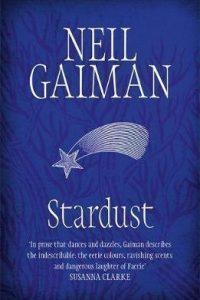“The tale started, as many tales have started, in Wall. Immediately to the east of Wall is a high grey rock wall, from which the town takes its name.”
A Victorian romance with a fantastical twist.
Stardust was Neil Gaiman’s third novel. Originally released by DC Comics as a form of picture book, it came out once a month as part of a booklet in 1997. Publishers encouraged Gaiman to rewrite it as an actual novel with fewer illustrations, and he published the final book two years later.
Matthew Vaughn adapted it into a film in 2007 with a variety of talented cast members. It differs vastly from the book and is a lot lighter and more family-friendly. Despite this, both the novel and the movie are loved by Stardust fans all over the world.
Summary
The story begins in 1839 as the Faerie Market rolls into the town of Wall, an event that only occurs once every nine years. Dunstan Thorn, a young and hopeless romantic, is immediately bewitched by an imprisoned woman. This chance meeting sets off a chain of events that neither of them could ever have prepared for. Eighteen years later, Dunstan’s son Tristran promises the most beautiful girl in town a fallen star in exchange for his greatest desire. From murderous witches, teleporting candles, lions and unicorns, pirate ships in the sky, and a topaz stone with the power to change the world, Tristran’s quickly realises that this will be no easy feat.
Commentary
Stardust is entertaining and witty and absolutely wonderful to read.
Praise
- This is perhaps the most imaginative story that I have ever read. It has an incredibly simple plot, yet the magic and mysticism make it new and exciting. Gaiman manages to take overused clichés and alter them to suit this Victorian setting in order to make the most brilliant world imaginable.
- Each character is unique. Everyone has different appearance’s and personalities, but they also have their own motives. It makes the novel intriguing and entertaining as everyone fights for their own benefit, and it isn’t until the very end that you realise how interconnected they all are.
- It’s realistic. Or, well, at least as realistic as a fantasy faerie world can be. Not everyone wins, a lot of people get seriously hurt (i.e. murdered) and there isn’t a stereotypical ending where they all lived happily ever after. It’s realistic and satisfying and makes the novel more enjoyable.
Critique
- Although this book is far from a fairytale, what with its graphic violence and twisted villains, it still has a fairytale-ish plot. As a result, the ending is quite predictable. From the very first moment you’re introduced to Tristran, you can see how it’s going to end.
- At the risk of giving spoilers, I’ll keep this part short. Towards the end of the novel, something a-little-bit-surprising-but-kinda-predictable happens. Although that’s fine on its own, how Tristran reacts to it is not. He should be shocked, but instead, he’s annoyingly blasé about the whole thing.
- Tristran himself isn’t the most likeable of protagonists. He kidnaps an injured girl to impress the ‘love of his life’ despite her having no interest in him at all. He objectifies a lot of the women he sees. And his feelings seem to change more than the wind. He’s misogynistic and flippant and this whole ‘boys will be boys attitude’ just doesn’t cut it in the 21st century.
Recommendations
Overall, I’d give Neil Gaiman’s Stardust a three out of five. It’s an imaginative if somewhat predictable tale of love, identity and power.
I’d recommend this novel to older children and teenagers, as it does have graphic and violent scenes. It’s an easy to read novel that can easily be finished in a few days.

Want to read it for yourself?
Prefer to listen instead?

I like the helpful information you provide to your articles.
I’ll bookmark your blog and check again right here frequently.
I am rather certain I will be told plenty of new stuff right
right here! Good luck for the next!
thank you!